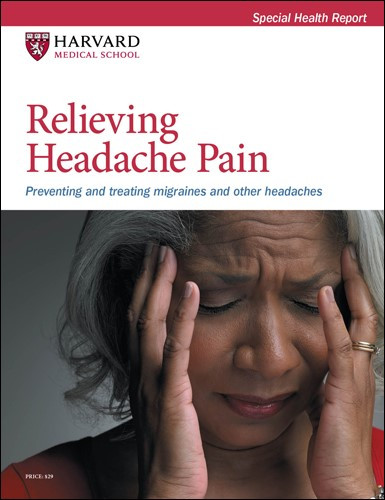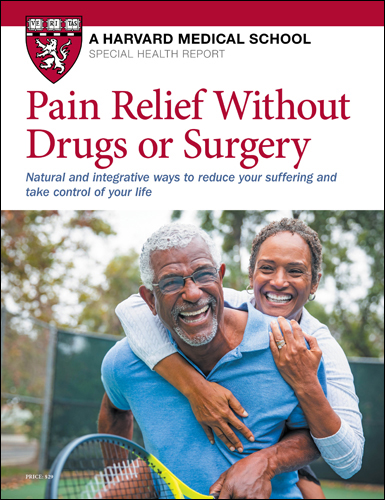
Less butter, more plant oils, longer life?

Healthier planet, healthier people

Counting steps is good — is combining steps and heart rate better?

Appendix pain: Could it be appendicitis?

Can saw palmetto treat an enlarged prostate?

How does Ozempic work? Understanding GLP-1s for diabetes, weight loss, and beyond

Zinc: What it does for the body, and the best food sources

Respiratory health harms often follow flooding: Taking these steps can help

Tips to leverage neuroplasticity to maintain cognitive fitness as you age

Can white noise really help you sleep better?


Relieving Headache Pain: Preventing and treating migraines and other headaches
Headaches inflict their misery in a variety of ways, from a dull, steady ache to a blinding, throbbing pain. Nearly everyone has them at least occasionally, but an unfortunate few experience near-constant head pain. This Special Health Report, Relieving Headache Pain: Preventing and treating migraines and other headaches, offers in-depth information on the most common kinds of headaches and the treatment strategies that work best for each, including a number of self-help and alternative techniques.
Other Product Information
Headaches inflict their misery in a variety of ways, from a dull, steady ache to a blinding, throbbing pain. Nearly everyone has them at least occasionally, but an unfortunate few experience near-constant head pain. Yet no matter how mild or severe your headaches are, many effective strategies relieve and even prevent headaches. This report offers in-depth information on the most common kinds of headaches and the treatment strategies that work best for each, including a number of self-help and alternative techniques, such as acupuncture, which has garnered more credibility in recent years as a way to avert recurring headaches. This report also explores a variety of preventive strategies, such as using stress management, physical therapy, or exercise in tandem with medications. Another aspect of prevention is learning to recognize and change things that may trigger your headaches — for example, reducing emotional stress, changing your diet, or getting more sleep. Advances in the medical management of headache mean that relief is no longer just possible, but probable. Although some form of head pain will occasionally visit most people, no one should have to live and suffer with headaches.
Prepared by the editors of Harvard Health Publishing in collaboration with Paul Rizzoli, M.D., FAAN, FAHS, Clinical, John R. Graham Headache Center, Brigham and Women's Faulkner Hospital; Assistant Professor, Harvard Medical School. 40 pages. (2021)
Treating migraine pain
When prevention fails, a variety of self-help strategies can help get you through an attack, especially if the attacks are not frequent. But when migraines occur on a regular basis, it’s time to speak with your doctor about a more powerful treatment.Throughout history, migraine sufferers have endured an odd array of alleged remedies. Ancient Romans zapped headache pain with a jolt from a black torpedo fish, or electric ray. In the 13th century, Europeans tried opium as well as rub-on vinegar potions. In 1660, a gruesome procedure dating back to prehistoric times known as trepanation (drilling holes in the skull) was popularized as a migraine treatment by the English physician William Harvey. Even then, doctors understood that swelling blood vessels in the head played a role in migraine pain. Erasmus Darwin (grandfather of Charles Darwin) proposed yet another bizarre treatment: spinning the patient in a centrifuge to force the blood from the head to the feet.
Over the next two centuries, other theories about the origins of migraines arose, including the notion of migraine pain as a “nerve storm” within the brain, similar to epilepsy. Today, epilepsy drugs—the anticonvulsant medications mentioned earlier —are among those used to prevent migraines, although they aren’t used for treating a migraine that’s in progress.
- Headache basics
- What type of headache do you have?
- When to see your doctor
- Diagnostic tests
- Keeping a headache diary
- Tension headaches
- Triggers and aggravators
- Relieving tension headaches
- Preventing tension headaches
- Sinus headaches
- How sinus headaches develop
- Managing sinus headaches
- Migraine headaches
- Anatomy of an attack
- Timing of attacks
- Who’s at risk?
- Migraine triggers
- Preventing migraine headaches
- Treating migraine pain
- SPECIAL BONUS SECTION: Self-help and alternative strategies to ease headache pain
- Chronic headaches
- Medication overuse headaches
- Managing chronic headaches
- Cluster headaches
- Managing cluster headache
- Resources
- Glossary
You might also be interested in…

Pain Relief Without Drugs or Surgery
Pain relief takes many forms. This Special Health Report, Pain Relief Without Drugs or Surgery, looks beyond the standard approaches of drugs and surgery and explores alternate pain-relief strategies, from acupuncture and mind-body therapies to spinal manipulation, physical and occupational therapies, herbal remedies, mindfulness meditation, and music therapy among others. The report also provides specific treatments for 10 common pain conditions.

Less butter, more plant oils, longer life?

Healthier planet, healthier people

Counting steps is good — is combining steps and heart rate better?

Appendix pain: Could it be appendicitis?

Can saw palmetto treat an enlarged prostate?

How does Ozempic work? Understanding GLP-1s for diabetes, weight loss, and beyond

Zinc: What it does for the body, and the best food sources

Respiratory health harms often follow flooding: Taking these steps can help

Tips to leverage neuroplasticity to maintain cognitive fitness as you age

Can white noise really help you sleep better?
Free Healthbeat Signup
Get the latest in health news delivered to your inbox!
Sign Up

